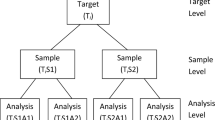Abstract
The bootstrap method, due to Bradley Efron, is a powerful, general method for estimating a variance or standard deviation by repeatedly resampling the given set of experimental data. The method is applied here to the problem of estimating the standard deviation of the estimated midpoint and spread of a sensory-performance function based on data sets comprising 15–25 trials. The performance of the bootstrap estimator was assessed in Monte Carlo studies against another general estimator obtained by the classical “combination-of-observations” or incremental method. The bootstrap method proved clearly superior to the incremental method, yielding much smaller percentage biases and much greater efficiencies. Its use in the analysis of sensory-performance data may be particularly appropriate when traditional asymptotic procedures, including the probittransformation approach, become unreliable.
Similar content being viewed by others
References
Davison AC, Hinkley DV, Schechtman E (1986) Efficient bootstrap simulation. Biometrika 73:555–566
Efron B (1982) The Jackknife, the bootstrap and other resampling plans. CBMS-NSF Regional Conference Series in Applied Mathematics, No. 38; Philadelphia, PA, Society for Industrial and Applied Mathematics
Efron B, Tibshirani R (1986) Bootstrap methods for standard errors, confidence intervals, and other measures of statistical accuracy. Statist Sci 1:54–75
Finney DJ (1964) Probit analysis. Cambridge University Press, Cambridge
Foster DH (1986) Estimating the variance of a critical stimulus level from sensory performance data. Biol Cybern 53:189–194
Hall JL (1981) Hybrid adaptive procedure for estimation of psychometric functions. J Acoust Soc Am 69:1763–1769
McKee SP, Klein SA, Teller DY (1985) Statistical properties of forced-choice psychometric functions: implications of probit analysis. Percept Psychophys 37:286–298
Numerical Algorithms Group (1984) FORTRAN library manual, Mark 11, vol 5. Numerical Algorithms Group, Oxford
Patterson VH, Foster DH, Heron JR (1980) Variability of visual threshold in multiple sclerosis. Effect of background luminance on frequency of seeing. Brain 103:139–147
Taylor MM, Creelman CD (1967) PEST: Efficient estimates on probability functions. J Acoust Soc Am 41:782–787
Author information
Authors and Affiliations
Rights and permissions
About this article
Cite this article
Foster, D.H., Bischof, W.F. Bootstrap variance estimators for the parameters of small-sample sensory-performance functions. Biol. Cybern. 57, 341–347 (1987). https://doi.org/10.1007/BF00338826
Received:
Issue Date:
DOI: https://doi.org/10.1007/BF00338826




